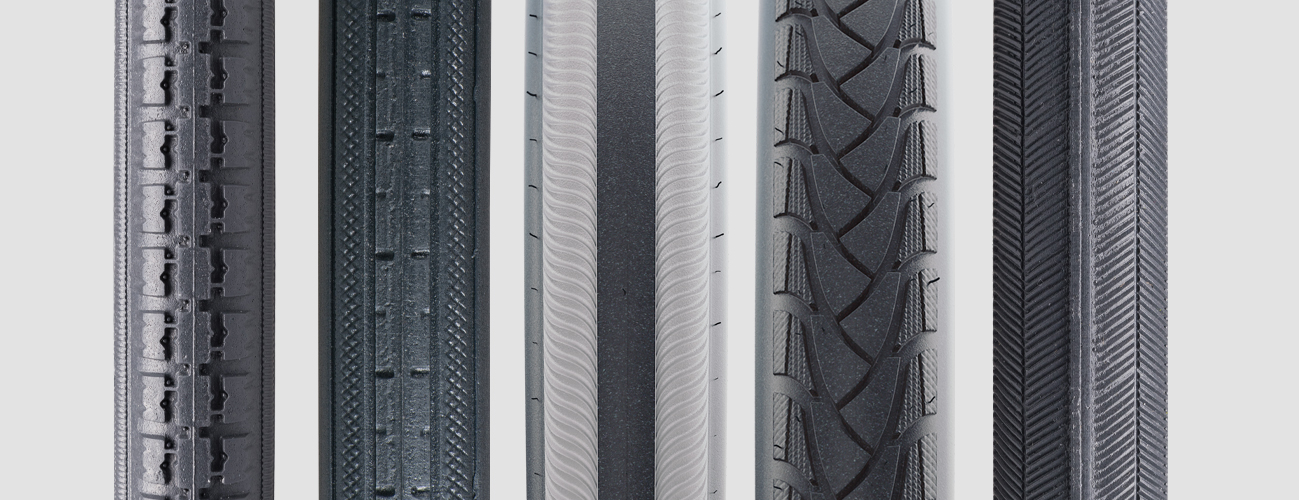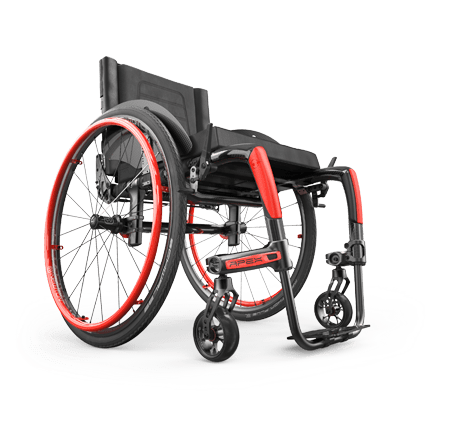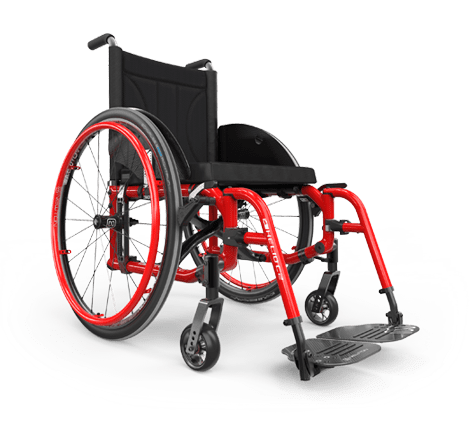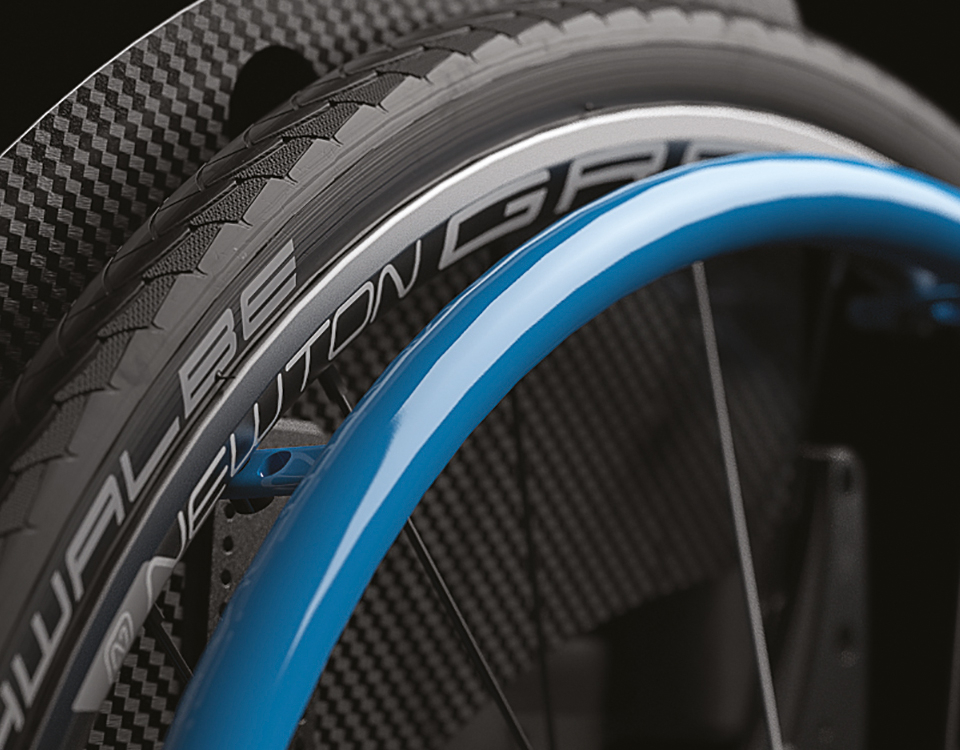This blog post examines the functional implications of tire selection and discuss what options are available. Like the biking industry, tire selection should be chosen for intended performance and terrain to be utilized on. There are a wide range of maintenance and cost differences, but these should be considered after the performance requirements are determined.
For the purpose of this article, we will discuss differences in types of tire, including performance, terrain, and maintenance, depending on selection.
Pneumatic
With a higher performance ultralightweight manual wheelchair, a higher performance tire is recommended. This usually means an air or pneumatic tire. This is also the lightest option when overall weight for optimum propulsion, or independent lifting of the chair is the end goal. Air tires also provide the best shock absorption and vibration damping. Clinically this can help with pain control and spasm management which can be often overlooked due to the maintenance requirements. There is often a no-cost pneumatic tire option given by manufacturers, but this may not give the best performance. Knowing how the chair will be utilized within the user’s environment will allow for the best clinical decision making.
There is a range of high pressure and treaded pneumatic tires available on most wheelchair order forms that can be selected based on the user’s specific performance needs.
While they do require some maintenance, pneumatic tires are the optimal choice for propulsion efficiency and comfort. Kwarciak et al 2009 looked at solid vs pneumatic tires in different tests for efficiency. The evidence clearly showed that air tires are the most efficient and at 50% of recommended inflation (or 50% flat) they still rolled with less resistance than a solid tire.
All manual wheelchair users should be informed of the pros and cons of pneumatic tires, and given a choice to optimize performance.
Solid/Urethane
A solid/urethane tire requires little to no maintenance and can be utilized with an ultralightweight manual wheelchair if the user is unable to maintain air, either themselves, or through a caregiver. While they are essentially maintenance free, performance and ride are significantly different than air. There is little shock or vibration absorption, and very little traction, leading to a bumpy and often uncomfortable ride outdoors, but performs well on indoor flat surfaces. They also are heavier and have increased rolling resistance, which has been demonstrated in multiple studies.
Pneumatic with airless insert
A third category is pneumatic with an airless or foam insert. This technically allows for the “feel of pneumatic, with no maintenance of a solid tire.” Unfortunately, this can add up to 1.5 times the weight of a pneumatic tire as well as significant rolling resistance, decreasing the overall performance of the chair and making it more difficult for the user to self-propel. There is also more wear on the tire which can be difficult to change when the tread wears out.

Tire tread also contributes to the overall performance. A larger knobby tread is better for traction, outdoor, and wet surfaces. A smooth, narrow, high pressure air tire is best for speed and maneuverability, both indoor and outdoor.
There are a wide range of tires in each category that have specific advantages and disadvantages; for example, there are many tires that are puncture resistant, or have varying levels of tread depending on environment. It is important for the clinicians and suppliers to understand the options and realize the importance that tire selection plays in overall wheelchair performance.
When deciding on tires, knowing lifestyle, environment, and preference can help determine what will be the best option. Do not make assumptions regarding maintenance and ride characteristics and involve the user in the selection process. Educate and empower with choice and allow the user to try different tire types. This will allow them to get the “feel” for the roll and could significantly enhance overall experience. Some users may choose to purchase a second set of tires and wheels to allow for easier access to multiple terrains. Best practice is matching the user’s need with the best performing material for them, not “what requires the least maintenance”.
Paying attention to the user’s needs and goals will allow for best matching of components to their lifestyle.
To summarize, some of the advantages and limitations of the three types of tires are included in the list below:
Pneumatic Tires:
Advantages:
- Generally lightest
- Shock absorbing
- Good traction on most terrain types
- The right amount of tire pressure can offer a softer ride over bumpy surfaces and provide that tactile grip which is important on wet surfaces
Limitations:
- Requires regular maintenance
- Tires should be checked weekly
- Inflation needed 1-2x per month
Solid/Urethane Tires:
Advantages:
- Designed to be fully puncture proof and low maintenance
- Durable against chemicals, sharp objects
- Wears at a slower rate
- Typically has higher tensile strength allowing it to carry heavier loads.
Limitations:
- Less effective on rougher terrain
- Heavier than air tires
- Recommend for indoor use (unless treaded)
- Usually a rougher ride
- Increased rolling resistance (poorer performance)
Foam Filled (Solid Inserts):
Advantages:
- More grip than solid/urethane tires
- Softer ride than solid/urethane tires
Limitations:
- More rolling resistance than pneumatic or solid/urethane tires
- Heaviest option
- Does not perform optimally outdoors
- Difficult to maintain over time
References:
Stephen Sprigle & Morris Huang (2015) Impact of Mass and Weight Distribution on Manual Wheelchair Propulsion Torque, Assistive Technology, 27:4, 226-235, DOI: 10.1080/10400435.2015.1039149
Bonita Sawatzky , Won Kim & Ian Denison (2004) The ergonomics of different tyres and tyre pressure during wheelchair propulsion, Ergonomics, 47:14, 1475-1483, DOI: 10.1080/00140130412331290862
KwarciakAM, YarossiM, RamanujamA, Dyson-HudsonTA, SistoSA. Evaluation of wheelchair tire rolling resistance using dynamometer-based coast-down tests. J Rehabil Res Dev 2009;46:931–8.









